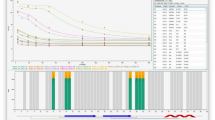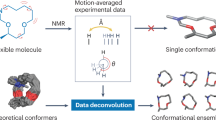Abstract
Model-free analysis is a technique commonly used within the field of NMR spectroscopy to extract atomic resolution, interpretable dynamic information on multiple timescales from the R 1, R 2, and steady state NOE. Model-free approaches employ two disparate areas of data analysis, the discipline of mathematical optimisation, specifically the minimisation of a χ2 function, and the statistical field of model selection. By searching through a large number of model-free minimisations, which were setup using synthetic relaxation data whereby the true underlying dynamics is known, certain model-free models have been identified to, at times, fail. This has been characterised as either the internal correlation times, τ e , τ f , or τ s , or the global correlation time parameter, local τ m , heading towards infinity, the result being that the final parameter values are far from the true values. In a number of cases the minimised χ2 value of the failed model is significantly lower than that of all other models and, hence, will be the model which is chosen by model selection techniques. If these models are not removed prior to model selection the final model-free results could be far from the truth. By implementing a series of empirical rules involving inequalities these models can be specifically isolated and removed. Model-free analysis should therefore consist of three distinct steps: model-free minimisation, model-free model elimination, and finally model-free model selection. Failure has also been identified to affect the individual Monte Carlo simulations used within error analysis. Each simulation involves an independent randomised relaxation data set and model-free minimisation, thus simulations suffer from exactly the same types of failure as model-free models. Therefore, to prevent these outliers from causing a significant overestimation of the errors the failed Monte Carlo simulations need to be culled prior to calculating the parameter standard deviations.
Similar content being viewed by others
Abbreviations
- AIC:
-
Akaike’s Information Criteria
- χ2 :
-
chi-squared function
- c k :
-
constraint value
- CSA:
-
Chemical Shift Anisotropy
- DMG:
-
Double Motion Grid
- ε i :
-
elimination value
- NOE:
-
nuclear Overhauser effect
- r :
-
bond length
- R 1 :
-
spin-lattice relaxation rate
- R 2 :
-
spin-spin relaxation rate
- R ex :
-
chemical exchange relaxation rate
- RG:
-
R ex Grid
- S 2, S 2 f , and S 2 s :
-
model-free generalised order parameters
- τ e , τ f , and τ s :
-
model-free effective internal correlation times
- τ m :
-
global rotational correlation time.
References
Andrec M., Montelione G.T., Levy R.M. (1999). J. Magn. Reson. 139: 408–421
Bellomo N., Preziosi L. (1994) Modelling Mathematical Methods and Scientific Computation, CRC Mathematical Modelling Series. CRC Press, Boca Raton, FL
Chen J., Brooks C.L., Wright P.E. (2004). J. Biomol. NMR 29: 243–257
Clore G.M., Szabo A., Bax A., Kay L.E., Driscoll P.C., Gronenborn A.M. (1990). J. Am. Chem. Soc. 112: 4989–4991
d’Auvergne E.J., Gooley P.R. (2003). J. Biomol. NMR 25: 25–39
Fushman D., Cahill S., Cowburn D. (1997). J. Mol. Biol. 266: 173–194
Korzhnev D.M., Billeter M., Arseniev A.S., Orehkov V.Yu. (2001). Prog. NMR Spectrosc. 38: 197–266
Lipari G., Szabo A. (1982a). J. Am. Chem. Soc. 104: 4546–4559
Lipari G., Szabo A. (1982b). J. Am. Chem. Soc. 104: 4559–4570
Mandel A.M., Akke M., Palmer A.G. (1995). J. Mol. Biol. 246: 144–163
Orekhov V.Yu., Korzhnev D.M., Diercks T., Kessler H., Arseniev A.S. (1999). J. Biomol. NMR 14: 345–356
Orekhov V.Yu., Nolde D.E, Golovanov A.P., Korzhnev D.M., Arseniev A.S. (1995). Appl. Magn. Reson. 9: 581–588
Palmer A.G., Rance M., Wright P.E. (1991). J. Am. Chem. Soc. 113: 4371–4380
Zhuravleva A.V., Korzhnev D.M., Kupce E., Arseniev A.S., Billeter M., Orekhov V.Yu. (2004). J. Mol. Biol. 342: 1599–1611
Author information
Authors and Affiliations
Corresponding author
Rights and permissions
About this article
Cite this article
d’Auvergne, E.J., Gooley, P.R. Model-free model elimination: A new step in the model-free dynamic analysis of NMR relaxation data. J Biomol NMR 35, 117–135 (2006). https://doi.org/10.1007/s10858-006-9007-z
Received:
Accepted:
Published:
Issue Date:
DOI: https://doi.org/10.1007/s10858-006-9007-z




